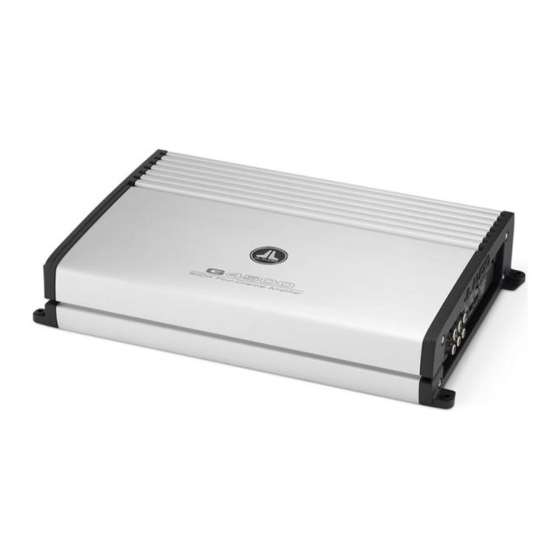
Advertisement
owner's manual
Thank you for purchasing a JL Audio amplifier for
your automotive sound system.
Your amplifier has been designed and manufactured to exacting
standards in order to ensure years of musical enjoyment in your vehicle.
For maximum performance, we highly recommend that you have
your new amplifier installed by an authorized JL Audio dealer. Your
authorized dealer has the training, expertise and installation equipment
to ensure optimum performance from this product. Should you
decide to install the amplifier yourself, please take the time
to read this manual thoroughly so as to familiarize yourself
with its installation requirements and setup procedures.
If you have any questions regarding the instructions in this
manual or any aspect of your amplifier's operation, please contact your
authorized JL Audio dealer for assistance. If you need further assistance,
please call the JL Audio Technical Support Department
at (954) 443-1100 during business hours.
Advertisement
Table of Contents

Summary of Contents for JL Audio G4500
- Page 1 For maximum performance, we highly recommend that you have your new amplifier installed by an authorized JL Audio dealer. Your authorized dealer has the training, expertise and installation equipment to ensure optimum performance from this product.
-
Page 2: Installation Applications
Cooling efficiency Considerations: The outer shell of your JL Audio amplifier is designed to remove heat from the amplifier circuitry. For optimum cooling performance, this outer shell should be exposed to as large a volume of air as possible. -
Page 3: Product Description
(See page 5 for important notice). The G4500 can be operated with a wide variety 7) Securely mount the amplifier. of source units and system configurations. 8) Connect the positive and negative power wires to the amplifier. -
Page 4: Input Section
12dB per octave. This is useful for connection of component speakers to one or both of the G4500’s channel pairs in a bi-amplified system. 2) “Filter Freq. (Hz)” The filter frequency... -
Page 5: Bass Boost Controls
Controls 2) “Sum”: When the G4500 is being used to drive front and rear speaker systems, this preamp output mode will deliver a summed front/rear stereo signal to a subwoofer amplifier, while permitting fading of the front and rear speaker systems from the source unit. - Page 6 JL Audio dealer so that it may be sent in to JL Audio for service. 2) “Protect” (Red): Indicates that the amplifier There are no user serviceable parts or fuses inside protection circuitry has been activated to the amplifier.
- Page 7 HF channels. The relative level of the front and This configuration requires that the separate rear HF channels will be fixed by the G4500’s “Input Sens.” settings and will not be user subwoofer amplifier has a built-in low-pass filter.
- Page 8 Following the directions below will allow the target voltage is observed with the voltmeter. installer to adjust the input sensitivity of each 9) Once you have adjusted the G4500 to its amplifier channel pair simply and easily in just a maximum low-distortion output level, few minutes using equipment which is commonly reconnect the speaker(s).
- Page 9 JL AUDIO G4500 Check your voltage source and grounding point. The power supply of the G4500 will operate with charging system voltages down to 10V. Shutdown problems at higher volume levels can occur when the charging system voltage drops below 10V.
- Page 10 Use this diagram to document your amplifier’s switch and control positions. JL AUDIO G4500 JL AUDIO G4500...
- Page 11 All warranty returns should be sent to JL AUDIO ’s Amplifier Service Facility freight-prepaid through an authorized JL AUDIO dealer and must be accompanied by proof of purchase (a copy of the original sales receipt). Direct returns from consumers or non-authorized dealers will be refused unless specifically authorized by JL AUDIO with a valid return authorization number.














